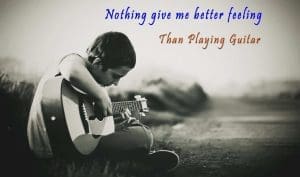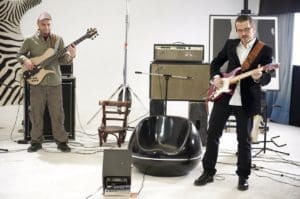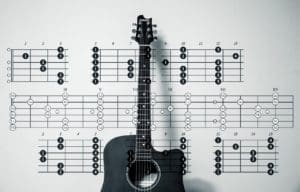Last update 5/2/2024
It’s an age-old question that has been asked by pretty much every beginner out there who ever picked up the instrument. Learning how to practice guitar can seem to be an uphill battle, mostly because there is just so much to comprehend at the start.
Table of contents
- How to practice guitar.
- Setting SMART goals
- Create a practice plan.
- Overcoming common challenges
- Enjoying the process
- Setting goals
- How do you practice guitar, and what is the best time, place, and frequency?
- Don’t let yourself become overwhelmed.
- What should I practice on the guitar?
- Notes on the fretboard
- Scales
- Soloing techniques
- How to practice guitar chords.
- How to practice guitar songs
- How to practice electric guitar quietly
- Conclusion
But it doesn’t have to be that way. The best way to answer this question is to break it into two separate ones: “How should I practice?” and “What should I practice.” They may sound similar, but they are entirely different things to consider. Let’s take some time to explore an answer to each and find out the best way to practice the guitar effectively.
How to practice guitar.
Playing the guitar is a rewarding experience, but it takes dedication and practice to reach your full potential. Many aspiring guitarists need help with effective practice methods, leading to frustration and slow progress.
This article will guide you in practicing the guitar correctly, setting you on the path to achieving your musical goals.


Here’s what you’ll learn
Setting SMART goals
Define specific, measurable, achievable, relevant, and time-bound goals for your guitar journey.
Create a practice plan.
Structure your practice sessions to focus on specific skills and techniques.
We show you how to develop effective practice habits. Learn slow practice, focused repetition, and active listening to maximize your learning.
Overcoming common challenges
We show you the strategies to combat boredom, frustration, and plateaus in your progress.
Enjoying the process
Remember, learning guitar should be a fun and rewarding experience!
By following the tips and strategies presented in this article, you can make the most of your practice sessions and see significant improvements in your guitar playing.
With dedication and the right approach, you can learn your favorite songs, develop your creativity, and experience the joy of playing music with your guitar.
“How” you practice the guitar is miles away from “what” you should practice. The word “How” implies developing a process. More accurately, it means creating an approach, a mindset that works best for you. No two guitar players are the same, however. So, it’s a safe bet to say that no two players should approach their practicing regimen similarly.
“There’ll come a writing phase where you have to defend the time, unplug the phone and put in the hours to get it done.” ~ James Taylor
Sure, there are some basic ideas that all practice plans need to have in them, and that’s what we’ll touch on. What’s important is to keep in mind that each of these points can and should be tailored to fit you and your personality as a player. That will ensure that you will benefit most from your practicing time.
Setting goals
Before you do anything else, you need to think about what kind of guitar player you want to be. Are you going to be a songwriter? Will you be very proficient with playing difficult chord changes and solos?


Figuring out what you want to achieve is very important because that will determine what kind of goals you need to set for yourself. There’s not a lot of sense in learning to be a finger-tapping, sweep-picking shred master. Well, not if your goal is to learn a few easy chords to play a handful of songs for the enjoyment of yourself, your family, and your friends.
Goals need to be set to challenge yourself. Nothing will keep you motivated; reach for the stars if they are too easy. At the same time, you don’t want to set your sights too high, however. Because if things get challenging and frustrating, it might lead you to lose interest altogether.
And that’s a bad thing.
How do you practice guitar, and what is the best time, place, and frequency?
You should pick a time of day when you’ll most likely be alert and hungry to learn. The best time to practice your guitar is different for everybody. Personal circumstances will dictate when and where you practice. Trying to practice when you’re tired or not in ‘prime shape’ may well defeat your purpose for practicing in the first place.


Guitar practice tips
As far as a practicing space is concerned. You should find a comfortable location where distractions can be minimal. Regardless of what some people say, work is an element of practicing. There is no getting around that fact. The best time and place to practice is when you can concentrate as much as possible. Short durations of concentration are much better than long durations. In fact, long periods of intense concentration will be detrimental. The reason that this is so is because of the way our brains work.
Time spent practicing guitar
How often do you plan on practicing? Every day? Three times a week or whenever the spirit moves you? Once you lock in on a frequency, that is the right balance between too much and too little. Then, considering how long to practice is your next step. Some players practice for hours upon hours. Every – single – day. Others are more than fine with knocking things out a few hours a week every few days.
Don’t let yourself become overwhelmed.
There are two ways to become overwhelmed; you must avoid them at all costs, both mentally and physically. Mentally, don’t bite off more than you can chew. That will frustrate you, and you may lose inspiration and the desire to practice. Take action if you find yourself feeling this way. Take a break for a while. Sometimes, returning refreshed is the best cure, as you will be more motivated.


Being physically overwhelmed usually happens to beginners. Learning to play the guitar is not easy. If your fingers hurt to the point of discomfort or certain arm/finger positions are uncomfortable, stop! That’s also a recipe for extinguishing the flame. Suppose things start to hurt (literally). Or, if some motion seems uncomfortable, take it slow and easy. Sometimes, trying to move too fast is more detrimental than helpful.
What should I practice on the guitar?
OK – so you’re all set with how you will practice. Now what?
Here’s where the rubber meets the road. Part of your goal setting is determining what aspects of playing the guitar you want to improve. There’s a lifetime of music theory topics and specific techniques that you can master with disciplined guitar practice.


The key is going after the ones that will help you move the fastest to get where you want to be and attempt to spend a certain amount of time on them with each practicing session.
Let’s take a look, shall we?
Notes on the fretboard
Music isn’t music without notes. Having a solid knowledge of where the 12 notes in the Western chromatic scale are located on the fretboard is a skill that will always be well worth the time spent.


There are many resources on different memorization techniques. Some of them are pretty ingenious. The good thing here is that it’s a simple memorization process. No advanced music theory is required!
Having solid knowledge may seem like a bit much at first. If you want to become a complete master at the guitar, knowing the ins and outs of where each note lies will make your development much easier as your knowledge progresses.
Scales
Scales are nothing more than patterns of different intervals or the distance between notes on the fretboard. A solid knowledge of scales and how they work is the cornerstone of an excellent soloing vocabulary.


There are countless books and lessons on scales; in fact, there’s no lack of information available. Everything from simple patterns to weaving different scales within the same song to significant musical effects, you’ll find everything.
Soloing techniques
Knowing scales is a natural lead-in to getting some sweet soloing techniques in your toolbox. Playing single notes all of the time will get, well, boring. Practicing and executing different skills properly will add a personal element to your playing. Furthermore, it will let you apply your emotions and personal ‘stamp. These are the building blocks for developing your style.


Techniques that can take you soloing to a whole new level include different picking techniques. Alternate, hybrid, and sweep. Developing a smooth vibrato, sliding accurately up and down the neck to land on a specific note, executing hammer-ons and pull-offs, and learning flowing legato runs. Also, there are other types of harmonics: natural, artificial, tapped, and finger tapping.
How to practice guitar chords.
In their purest form, chords are nothing more than taking a few particular notes from a scale and playing them all together simultaneously.
Chords are the backbone and building blocks for almost any song you’ve ever heard. Having good chord knowledge is a ‘must-have’ for any guitarist—no matter what kind of guitarist you aspire to be.


Different types of chords range from what we’ll call the ‘basics’ :(major, minor, dominant 7th, and major 7). In addition, there are more complex chords that add flavor and style to a composition. Jazz is an excellent example of how these more complicated chords create a unique sonic texture. They can take you to a different place. Furthermore, they are great catalysts for increasing your creativity.
A critical chord-related skill for players looking to become a little more advanced is learning to play them in different positions along the neck. There also needs to be an emphasis on ‘inversions.’ Inversions are merely taking a set of notes and flipping them around to play them in a different order. The overall sound is relatively the same, but the ‘color’ can be refreshingly different.
How to practice guitar songs
One of the best ways to put everything that you’ve learned (and get some real-life application) is to try and learn your favorite songs. There’s a sense of satisfaction when you finally nail your favorite tune. It’s one of the best ways to keep your motivation up. Learn some easy songs as soon as possible, and create a repertoire so that if anyone asks you to ‘play something,’ you can do so.


Challenge yourself! Learning songs that easily fit in the box regarding your skillset may get a little boring after a while. Suppose there’s a song where you feel you may have to push yourself a little bit (or even a lot), then great. It’s always a good thing to keep your chops and skillsets as good as they ever can be. There’s a great deal of satisfaction to be had by doing so.
Another benefit of learning to play songs is that it’s one of the most effective ways to work on ear training. Developed guitar players have a sense of ‘hearing’ things, such as recognizing different types of chord progressions. In addition, identifying a chord type only by how it sounds is very beneficial for your heart training.
Sometimes, putting the chord charts and guitar tablature to the side is a worthy exercise. Go ‘old school’ and learn how to play a song by listening to it. Again, excellent ear training.
How to practice guitar better
Practice slowly
The following technique is essential when you practice playing a new song or a musical piece, for example, lead melody lines! Practice slowly! We all want to play any new song at full playing speed as soon as possible. Practicing slowly will have you playing faster sooner.
Practicing slowly will have you playing faster sooner.
The Golden Rule
One general rule will be applied to almost everything in life, as well as guitar sounds. It’s like a fine thread that runs through the fabric of acquiring skills and evolving in life.
Namely, whatever you do, do it with baby steps first, but do it consistently. If you become overwhelmed with too much information and knowledge to digest, you will likely give up and ultimately fail. On the other hand, if you take it one step at a time, you will be carried by a sense of accomplishment since you won’t be frustrated with taking too much upon yourself all at once.
If you continue that practice regularly, you will be amazed at how fast incremental improvement can get you to the desired place. Yes, we know it sounds counterintuitive, but trust us…We have been there.
How to practice guitar like a Pro
Most of us artistic people tend to be somewhat snowflakey, and we want it all and want it now (sounds familiar?). Thus, the point of this article is not for it to be like some dogma but rather a guide to get you going. Starting your creative journey by imitating others and strictly following specific guidelines is healthy. But remember, all of the sounds you have heard that you liked very much were a product of someone’s imagination and creative “misbehavior.”
Breaking specific rules is crucial in getting your creative side out at a certain point. So, don’t be afraid of experimenting!
How to practice electric guitar quietly
Electric guitars are great, but one thing they’re not always great at is being quiet. If you live in an apartment or have neighbors nearby, practicing your electric guitar can be challenging.


We are going to state the obvious, starting with acoustics. Unplug that amp or, better yet, invest in a headphone adapter for your setup. It’s a game-changer for silent but powerful practice sessions.
Now, amp settings are your ally. Lower the volume, adjust the gain, and explore the headphone options on your amp if available. This lets you dial in your sound without disturbing anyone.
Use headphones
This is probably the easiest and most common way to practice your guitar quietly. Just plug your guitar into your amp and then plug your headphones into the amp’s headphone jack. This will send the sound of your guitar directly to your headphones, so you won’t have to worry about bothering anyone else.
Practice unplugged
Sometimes, the best way to practice your guitar quietly is just to unplug it.
Next, consider your playing style. Experiment with fingerpicking or softer techniques like palm muting to keep things stealthy. It’s a chance to refine your touch and control.
Here’s a pro tip: practice scales, chords, and licks with a light touch. You’ll maintain precision and control while keeping the noise levels in check.
Conclusion
As you can see, developing a robust, comprehensive plan that you’re comfortable with is the best way to practice the guitar. The strategy needs to have two distinct parts to it.
Determine how to practice guitar with your schedule and process along with ‘what’ to practice, for example, skills, techniques, and music theory. It will take some trial and error at the start. However, eventually, you’ll land on a mix of the two that’s ‘just right.
Oh…before we sign off, there’s one other vital thing that you, positively, must always keep in mind. It’s OK not to be perfect. Practicing and putting time in is the only way to become proficient in guitar. That means you will make mistakes. Some things will take you longer to grasp and perfect than you thought. So what if they do? Look at them as challenges to overcome, not as roadblocks.
But that’s how you learn. Learning how to practice the guitar effectively will eventually lead you to your ultimate goal, whether that’s strumming a few tunes with your friends around the proverbial campfire or jamming out live on stage. Or you are just being happy with the fact that you did it. Try to stay motivated and set realistic goals. Give yourself time.
The time will come when all that practice will pay off; You’ll be glad you made an effort.
Transparency disclosure: Some of the links in this post are affiliate links, meaning that I may earn a commission if you click on a link and make a purchase. This commission comes at no extra cost to you. We only recommend products and services that I believe are helpful and valuable, and we never let the potential for a commission influence our recommendations.
Great books about how to practice the guitar at Amazon.



